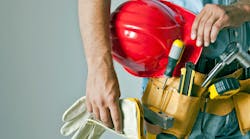Those of us who perform electrical work rely on our tools — and with them we earn a living. They imbue us with our superpowers; they give us the ability to assemble, build, diagnose, repair, and modify as needed for any given project. Our tools allow us to apply these talents across an array of components, equipment, systems, and installations. We routinely perform difficult tasks, and sometimes we do the impossible — thanks to our skill with these tools.
Yet for all that, our tools can betray us if we are not careful. Disfiguring injuries to eyes, hands, fingers, and other body parts can easily result from tool safety mistakes. The good news is those mistakes can be avoided by following some simple principles and practices. Let’s start with hand tools.
Hand Tool Safety Tips
The two main causes of injury with hand tools are:
1. Using the wrong tool for the application.
2. Using a tool that is worn, chipped, broken, or damaged in some other way.
Follow these tips:
• When buying a new tool, select an industrial-use, premium version that won’t fail under use the way a cheap one will. Look for tools with ergonomic features (for example, a fat handle on a screwdriver).
• If the tool you want does not have insulated handle(s), either buy one with such handles or look into a retrofit solution. Most brands marketed to electricians have insulated handle versions.
• Select the right tool for the job rather than using what’s handy. For example, don’t use a screwdriver as a scraper or pry bar, and don’t use pump pliers instead of a wrench.
• Screwdrivers come with different blade styles and sizes. Use the blade that fits the slot.
• Never use any tool for impact work unless it’s designed for that purpose; otherwise, it may shatter.
• Clean and inspect tools before and after use. If a tool is damaged, don’t use it. A damaged tool can slip or break. This can damage the work surface. Worse yet, it can result in anything from a puncture wound to broken bones to electrocution.
• Replace or sharpen dulled cutting tools. However, don’t grind the chip off a chipped screwdriver; that doesn’t repair it.
• If your adjustable jaw pliers, wrenches, or socket drivers exhibit slop or binding, replace them.
• Replace any socket that has any damage whatsoever.
• Use tool organization systems that fit your work style, protect your tools, and allow you to easily retrieve the tool you need when required.
• Wear safety glasses to protect your eyes and work gloves to protect your hands. When using cutting tools, wear cut-resistant gloves made specifically for that purpose.
Hydraulic Tool Safety Tips
Hydraulic tools are great labor savers, and they prevent the kinds of injuries you might get from trying to exert the same force manually. Yet, to do this, they operate with enough pressure to cause serious injury.
The two main sources of injury are:
1. Using a damaged hydraulic tool.
2. Failing to properly secure the part(s) being worked on.
Follow these tips:
• Visually inspect the hydraulic tool before use. Replace any hose that is cracked, worn, or damaged in any way.
• If possible, do a low-pressure test run of the tool to check for leaks. A pinhole leak at 30 PSI may get your sleeve wet; at 5,000 PSI, it may sever your arm.
• If you discover a leak at a fitting, don’t just tighten it. Perhaps the fitting is cracked, causing it to leak. Tightening could make the problem worse. Return the tool to the tool crib (if there is one), or disassemble, clean, and reassemble with a new fitting.
• Clean up hydraulic fluid leaks immediately, using the appropriate method and personal protective equipment (PPE).
• Never hold work pieces with human hands (yours or those of a coworker). Ideally, you will clamp the pieces in place. If that’s not practical, hold them using pliers (e.g., “vice grips”) with sufficient handle length to ensure no human body parts are in harm’s way.
• Some hydraulic tools use a compressor; in such a case, hearing protection is required.
Powder Tool Safety Tips
Powder tools are used where, for example, it’s necessary to drive an anchor deep into a wall. They are most often used with hollow block and concrete. They are really firearms, so precautions similar to those at a shooting range apply.
For example:
• Let only qualified people use them.
• Wear hearing and eye protection if you’re in the area where they are being used.
• Inspect the tool before and after use, following the manufacturer’s recommended inspection procedure.
• Keep the tool unloaded until you are ready to use it.
• Never point it at anybody, even if it’s unloaded. Don’t point it up, either. Any time it’s not in its case, point it toward the ground unless you are using it.
• If you don’t have a way to lock up unused loads, leave them with someone rather than leave them unattended.
• Select the correct tool for the application; not every application justifies a high-velocity tool.
• Select the correct powder charge for the base material and other factors that characterize the application. Follow the manufacturer’s procedure for determining the base material suitability.
• Don’t use powder tools in Hazardous Locations [as defined by Art. 500 of the National Electrical Code (NEC)].
• Use the adapter, fixture, shield, etc., specified by the manufacturer.
• Drive into an existing hole only if you use a guide supplied by the manufacturer for that purpose.
• Hold the tool perpendicular to the surface you are trying to penetrate or you may get discharge in unintended directions.
• If the tool misfires, hold it against the work surface for at least 30 seconds. Then, follow the misfire procedure (know the procedure before using the tool).
Power Tool Safety Tips
Twenty years ago, an industrial power tool required a portable cord. Today, electricians commonly use an array of industrial power tools that have long-lasting lithium batteries and plenty of torque. They also benefit from bright LED work lights powered by either portable cords or batteries. The headlamp, once rare, is now practical because of its lightweight LED and long runtime.
Just because we can see better and don’t have the cord management headaches we used to have doesn’t mean we can take safety for granted. Regardless of how a rotating tool is powered (cord or battery), it is still a rotating tool. Thus, you should always wear safety glasses when using one. A saw is loud regardless of how it’s powered, so you still need hearing protection to use one even if it’s battery-powered.
Another factor related to rotating tools is long hair and long sleeves, which each pose special dangers, so take the obvious precautions.
As with any other tool, inspect before and after use. You may not need to inspect a power cord for every tool anymore, but the tool and its accessories need inspecting. And now, instead of managing power cords, you must manage batteries. Start your shift with a freshly charged battery.
If you plan to use a saw heavily on a given day, it’s safer and more economical to start your day with a new blade rather than wait until whatever is in the tool starts bucking you when you try to cut with it. This might seem expensive, but it’s more expensive to interrupt your workflow for a blade change. This practice improves productivity and prevents work piece damage while simultaneously eliminating a safety issue.
Other tips:
• Use the dust collector attachment for your saw or drill, especially if working on gypsum.
• Use the side handle attachment for a drill to prevent wrist injury.
• Rather than carry tools up and down ladders, raise and lower them with a rope.
• Use the correct bit or blade for the material — same with speed.
• If the tool bogs down, stop. You either have a cutting error or your battery is too weak for the work; both conditions are dangerous.
• Where practical, tape both sides of a material before drilling or cutting it; this reduces burrs and splinters.
• Remove rough edges from the material after completing the drilling or cutting operation.
The Tool Safety Mindset
These tips are by no means a complete checklist for safe tool usage. Consider them as examples of tool safety principles. One of the principles you probably noticed is to make sure your tool is ready to work when you are. That is the case regardless of how your tool is powered.
Tool-related injuries happen, but they don’t need to. The practices that protect you from such injuries also reduce work error rates and improve productivity. When it comes to tool safety, forethought is superior to afterthought.




